

Wilmot, Tasmania
Wilmot is one of those kind of places where the journey getting there is as much fun as being there. The big drawcard for me was always the original Coles family store (sadly it's no longer there), from which came "GJ", the son George who decided to move to the mainland and Melbourne, where he figured he had more chance to make a million that if he stayed in the backblocks of North West Tasmania. It was a move that paid off handsomely - his venture grew into the gigantic Coles retail empire we see today. It was at Wilmot that the one-time chairman and managing director of the company, Norman C. Coles, received his primary education at the time when his older brother A. W., later Sir Arthur, was assisting his father.

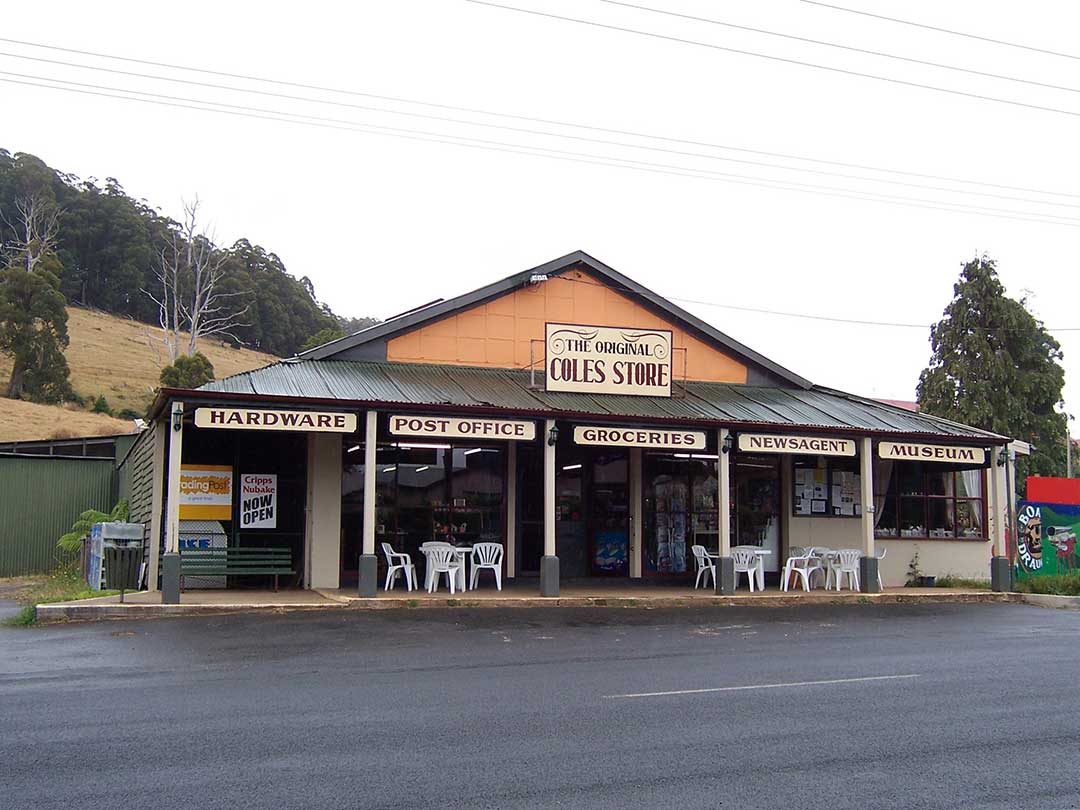
The original Coles store, which burnt down in January 2014. The store was operated by the Coles family from 1910-1921.
Back when the Coles brothers were honing their retail skills, Wilmot was pretty much the sleepy little village in the foothills of the Great Western Tiers that it is today. It still services the surrounding rural area but benefits from being on an alternate, quieter route to Cradle Mountain than the one most people take, and so its general store and a few B&Bs around town benefit from far more passing trade than they used to.
Prior to European settlement the area was occupied by members of the Tommeginne Aboriginal language group. White settlers didn't move into the area until the 1890s, and were confronted with the daunting task of clearing land which was densely timbered. Wilmot was a Parish name prior to 1900 but no town of that name had been surveyed. A Wilmot post station existed in 1899. The town name was proclaimed in 1903, and Wilmot was gazetted as a locality in 1965. The locality was named for Sir John Eardley-Wilmot, 1st Baronet, Lieutenant Governor of Van Diemen's Land (now Tasmania) from 1843 to 1846.
In 1904 the Wilmot Butter Factory was built, however is was destroyed by fire in 1912, two years before George Coles, father of the founder of G. J. Coles Ltd, moved from Victoria with his second wife and some of his family to Wilmot to take over the village store. Ironically, that store would suffer a similar fate 102 years later.


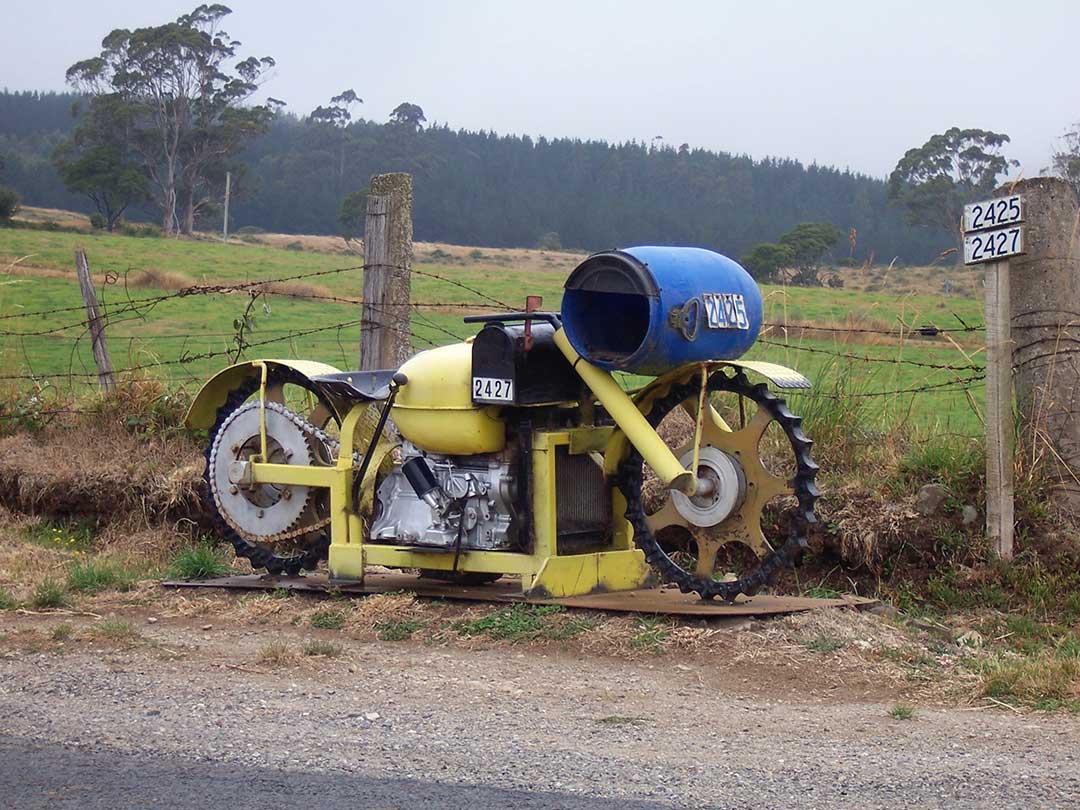
Whichever way you come up to Wilmot from the coast - and you have a choice of two - you are in for a visual treat. Follow the road from Wilmot to Devonport travel up through the aptly named 'Valley of the Views', which is also known as the Wilmot Novelty Letterbox Trail. Not only will you be treated to some great scenery, you'll find the road is lined with the most interesting and unique array of letterboxes you are ever likely to see. Someone started the trend a few decades ago, it caught on and now everyone has one! Now that's community spirit for you. Also look out for the graphic portrayal of Wilmot's history by local artists and school children on telegraph poles along the road.
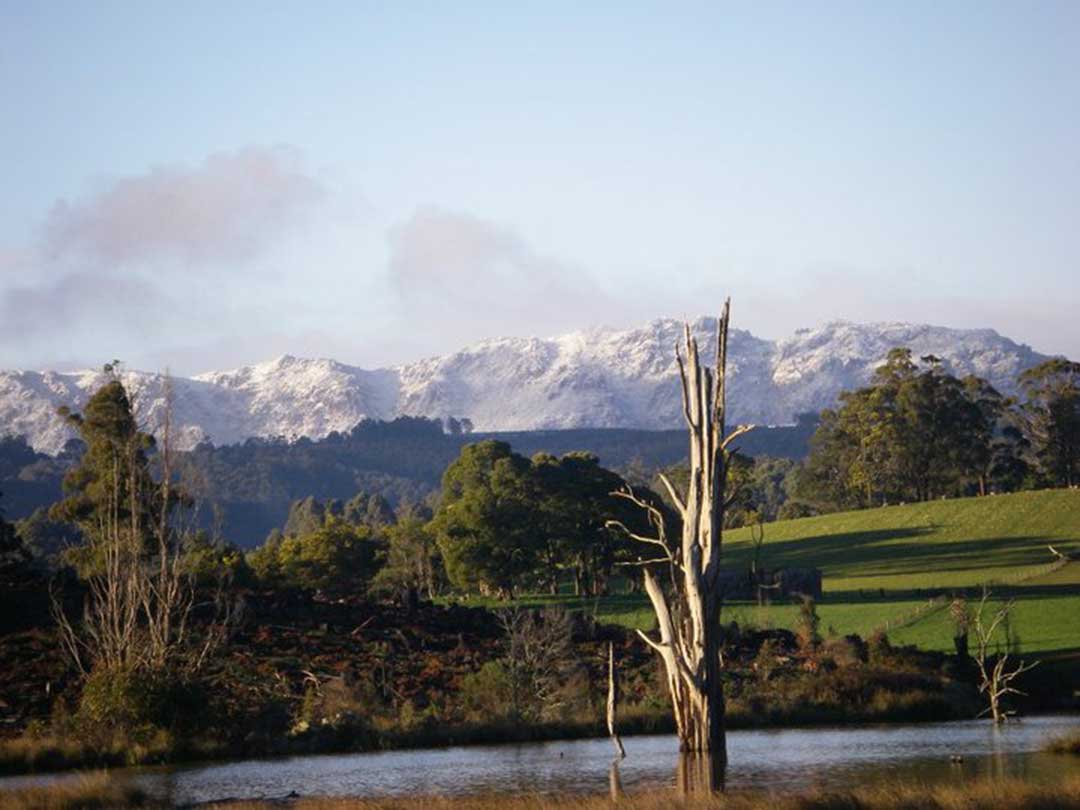
Come via Sheffield and you'll encounter numerous roadside lookouts with views to Mount Roland and Lake Barrington, and a few challenging walking tracks. The 20-minute climb to the summit of Bell Mountain (803 metres) is steep but rewards you with uninterrupted, 360-degree views of surrounding mountains including Mount Roland, Mount Claude, Mount Vandyke, the Great Western Tiers, Cradle Mountain and Black Bluff.

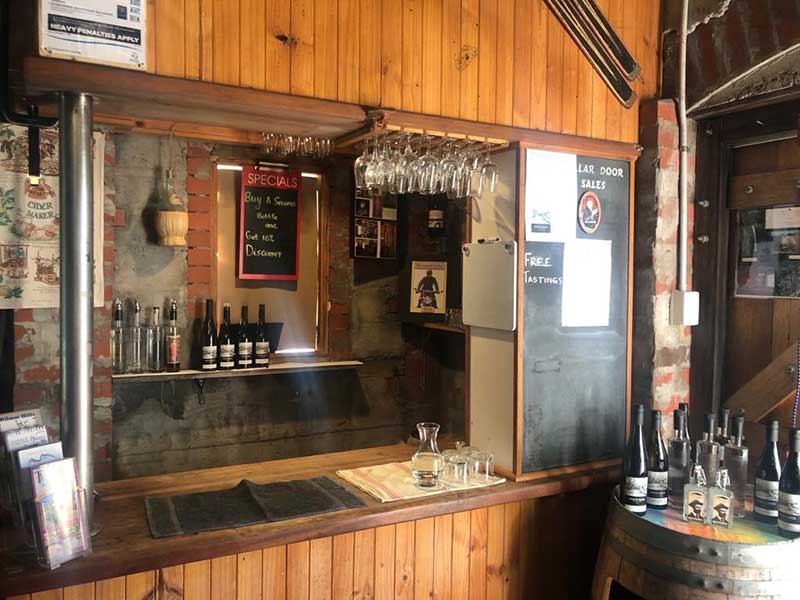
WILMOT HILLS ORCHARD & DISTILLERY Wilmot Hills Orchard & Distillery is a small boutique distillery. The cellar door is open 6 days a week (closed Wednesdays), offering Cheese, Cold Cured Meat platters and Thin based Wood fired Pizzas, by prior arrangement only, usually a weeks notice is required.
407 Back Road, Lower Wilmot, 7310
Ph: (03) 6431 7171


The original Coles store, which burnt down in January 2014. The store was operated by the Coles family from 1910-1921.
Back when the Coles brothers were honing their retail skills, Wilmot was pretty much the sleepy little village in the foothills of the Great Western Tiers that it is today. It still services the surrounding rural area but benefits from being on an alternate, quieter route to Cradle Mountain than the one most people take, and so its general store and a few B&Bs around town benefit from far more passing trade than they used to.
Prior to European settlement the area was occupied by members of the Tommeginne Aboriginal language group. White settlers didn't move into the area until the 1890s, and were confronted with the daunting task of clearing land which was densely timbered. Wilmot was a Parish name prior to 1900 but no town of that name had been surveyed. A Wilmot post station existed in 1899. The town name was proclaimed in 1903, and Wilmot was gazetted as a locality in 1965. The locality was named for Sir John Eardley-Wilmot, 1st Baronet, Lieutenant Governor of Van Diemen's Land (now Tasmania) from 1843 to 1846.
In 1904 the Wilmot Butter Factory was built, however is was destroyed by fire in 1912, two years before George Coles, father of the founder of G. J. Coles Ltd, moved from Victoria with his second wife and some of his family to Wilmot to take over the village store. Ironically, that store would suffer a similar fate 102 years later.

Wilmot's "Coles" Connection
The personal link which the Coles family has long enjoyed with Tasmania began in the early years of the century. Victorian shopkeeper George Coles Senior had run a number of general stores across rural Victoria, but due to ill health, moved to Wilmot in 1910 to take over the village's bankrunpt general store. Eager to turn the company around, Coles' eldest son George James "G.J." Coles (1885 - 1977), who worked in the store with his father and brothers, decided to investigate the F. W. Woolworth's 'five and dime' stores that were enjoying success overseas.

Whichever way you come up to Wilmot from the coast - and you have a choice of two - you are in for a visual treat. Follow the road from Wilmot to Devonport travel up through the aptly named 'Valley of the Views', which is also known as the Wilmot Novelty Letterbox Trail. Not only will you be treated to some great scenery, you'll find the road is lined with the most interesting and unique array of letterboxes you are ever likely to see. Someone started the trend a few decades ago, it caught on and now everyone has one! Now that's community spirit for you. Also look out for the graphic portrayal of Wilmot's history by local artists and school children on telegraph poles along the road.

Come via Sheffield and you'll encounter numerous roadside lookouts with views to Mount Roland and Lake Barrington, and a few challenging walking tracks. The 20-minute climb to the summit of Bell Mountain (803 metres) is steep but rewards you with uninterrupted, 360-degree views of surrounding mountains including Mount Roland, Mount Claude, Mount Vandyke, the Great Western Tiers, Cradle Mountain and Black Bluff.


WILMOT HILLS ORCHARD & DISTILLERY Wilmot Hills Orchard & Distillery is a small boutique distillery. The cellar door is open 6 days a week (closed Wednesdays), offering Cheese, Cold Cured Meat platters and Thin based Wood fired Pizzas, by prior arrangement only, usually a weeks notice is required.
407 Back Road, Lower Wilmot, 7310
Ph: (03) 6431 7171
Beyond Wilmot

When you leave Sheffield, you have a the opportunity to take a slight deviation and go through the most quaintly named place in Australia - No Where Else. What is there at No Where Else? Not much really, there are no shops, no pub, no general store or toilets, just a few farm houses and an interesting sign to have your photo taken under! Nowhere Else came into being because the original road from Barrington ended at the entrance to a farm. When drivers asked the farmer what was further on he told them 'No where Else'.
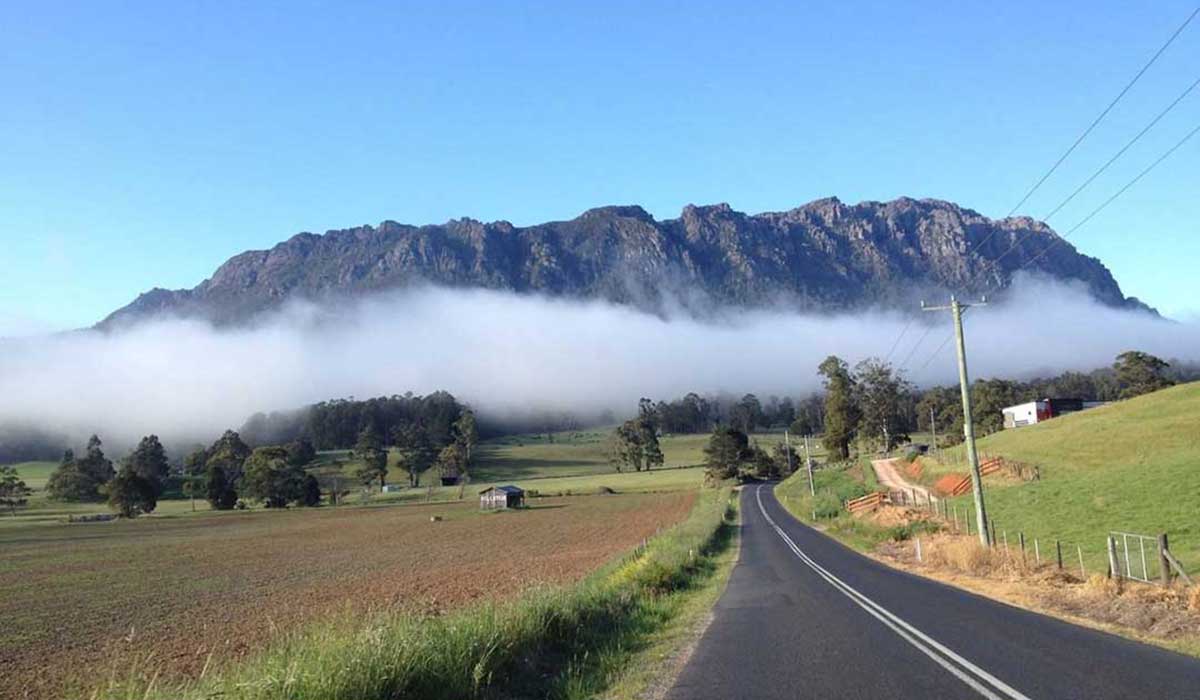
If you follow Nowhere Else Road, you'll head towards Mt Roland, which sits in all its magnificence in front of you. On the way you'll passed through another interestly named place - Promised Land. Stop the car and check out the scenery and you'll see why it's called Promised Land. There is also a Paradise and a Crackpot (this refers to a town, not a person) in this neck of the woods, just in case you thought a place name can't get any stranger than Nowhere Else.

Paradise was named by a land-prospecting farmer who came through dense undergrowth cover, emerging to find a magnificent view of Mt. Roland. Sitting down at the base of a large gum tree, he was said to exclaim "This is truly paradise". Scottish pioneer settlers bestowed these unusual place names as they opened up the land. Since many of them had been forced off their lands by English Lords or religious persecution, it is no wonder that they viewed this place as a gift of providence. Paradise is considered by those who live there to be the gateway to the best of the Tasmanian Wilderness areas - including the spectacular Cradle Mountain and Lake St Clair National Parks, Liffey Falls and the Mole Creek caves. If you've ever been to any or all of those places, you can understand why someone would consider living on their doorstep to be "paradise".
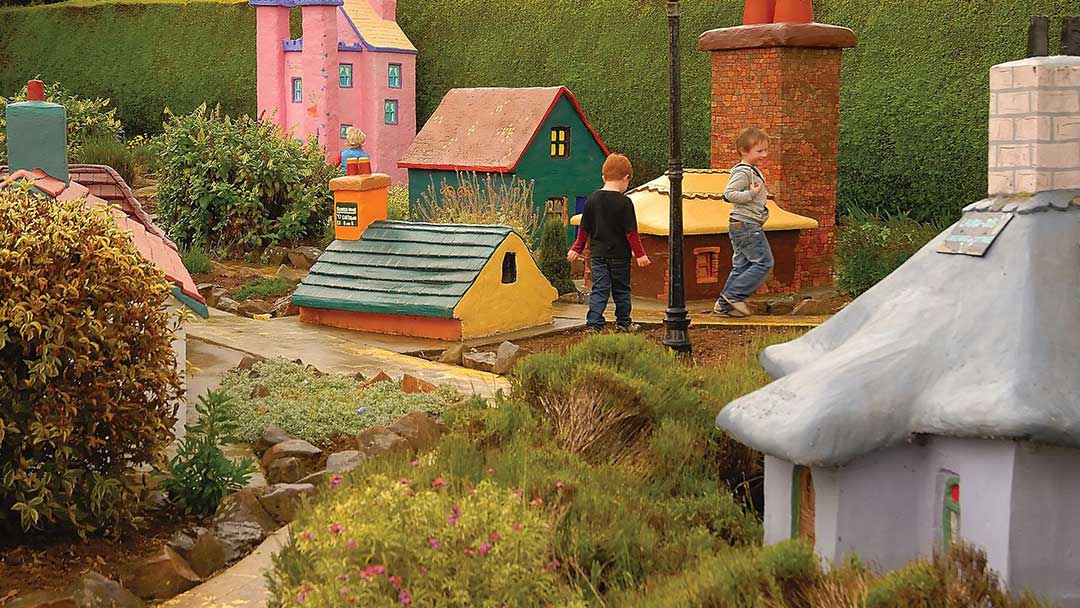
Village of Lower Crackpot
Village of Lower Crackpot
30.9 km south-east of Cradle Mountain Road and CethanaAs for the Promised Land, given how quirky everyplace around it is, it will come as no surprise that the main attraction here is the village of Lower Crackpot. Part of Tasmazia (where else?), Lower Crackpot is a whimsical model village built to 1/5th scale. Each building has a story to tell, and is connected to real people. There is the Cathy Freeman Sports Centre. Sir Joh Bjelke Petersen is the member for Lower Crackpot, complete with ivory tower.
The village is dedicated to all those in middle life who, in this new economic age, are 'adjusted' out of their jobs, professions, businesses, farms, careers and thrown onto the economic scrap heap, there to start again, some way, as happened to its creator, Brian Inder at age 54. The village, at the entrance to Lake Barrington International Rowing Course, is meant as an inspiration to these people - you can pick yourself up and succeed in a new life, you can thumb your nose at the "new order" and still have a ball.

Lake Barrington
6.7 km km north-east of Wilmot via Watty RoadTo ease you back into a normality, there is a sign just up the road from the entrance to the village of Lower Crackpot that points to Lake Barrington, which is just a short distance away. Lake Barrington was created when the Forth River was damned in 1969 to provide a head of water for the Devils Gate Bydro-Electric Power Station. The foreshore is protected by the Tasmanian Government as a nature recreation area. Best known for its 2,000 metre, eight-lane international-standard rowing course (used by Australia's Olympics rowing team for training purposes), used also for canoeing and water skiing competitions, the reserve has picnic areas with sheltered tables, BBQs and toilets are available within the reserve. A kiosk operates on weekends in summer and during major sporting events. Lake Barrington is .
The lake is a popular water ski location with access via West Kentish on one side of the lake and Wilmot on the other. There are two water ski clubs based at Lake Barrington: Kentish Aquatic Club and Horsehead Water Ski Club. The lake is also used for canoeing and trout fishing. There is an adventure playground and a two-hour rainforest walk.
When you finally make it to Wilmot there are a few things you can do in and around town. Wilmot's rich pioneer history is well documented at the Museum in Main Street. The displays include historical information, old relics and an extensive display of photographs. Visitor information available.


Lake Cathana
18.3 km km south of Wilmot via Cradle Mountain RoadLake Cethana is a Hydro Tasmania lake near Moina in north west Tasmania. It is one of the Hydro Tasmania storages on the River Forth and directly upstream from Lake Barrington. Cethana Power Station was opened in 1971, and is one of only a few underground hydro stations in the state. It has one Francis turbine with a generating capacity of 85 MW of electricity. The station is run by the waters of Lake Cethana.
Part of the Mersey–Forth scheme that comprises seven hydroelectric power stations, the Cethana Power Station is the fifth station in the scheme. The power station is located underground and is supplied with water from Lake Cethana, the Wilmot Power Station located below Lake Gairdner, and uncontrolled flow from the Forth River. Water from the station is returned to the Forth River through a tailrace tunnel which has a tailrace gate structure at the outlet portal.


Forth Falls
2 km km east of Wilmot via Williams RoadForth Falls is a series of picturesque waterfalls and cascades on Forth Falls Creek, that meanders its way into Lake Barrington. On the northern side of Wilmot there is a turn to the left that heads down to Lake Barrington. A few kilometres down the road a right turn is taken. Immediately to the right there is a car park to the right. The track to Forth Falls commences here. A half hour walk on an easy track takes you to the gorge which hosts the falls. At this point the track splits in two and the going gets tougher. The left branch descends down to the fiver where the lower falls are found - 10 minutes. The track to the right heads very steeply to the upper falls - about 20 minutes. The track to the falls from the junction is rough with numerous loose rocks. The tracks would be particularly difficult in wet conditions.
While you won’t notice the unobtrusive Bell Mountain from afar its location affords unparalleled 360 degree views across Tasmania’s Central Highlands to the south; Lake Cethana, Cradle Mountain, Barn Bluff and Mount Roland to the east. To the west is the Dial Range and Valentines Peak; To the north the views are complemented by a vista of tapestry agricultural farmland dissected by the Forth River Valley, Lake Barrington, and through to Tasmania's northern coastline. The walk is a steep 45 minutes to the summit and only 20 minutes return. Due to the steepness of the track and the slippery terrain bushwalking boots are recommended. Access is from the bottom of the Cethana Gorge and is a short diversion when coming from Wilmot or Sheffield.

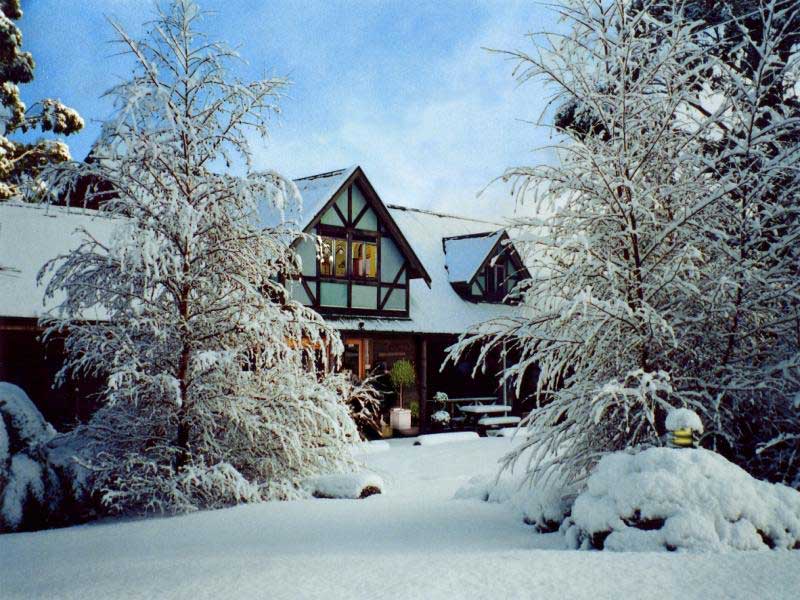
Cadle Forest Inn, Moina
Moina
16.5 km km south of Wilmot via Cradle Mountain RoadMoina was the site of a brief gold rush in the late nineteenth century and then one of the largest wolfram and bismuth mines in Tasmania. It has been the centre of continued mineral exploration in the Middlesex district since the first discoveries of tin and tungsten ores on Dolcoath Hill in the 1890s.
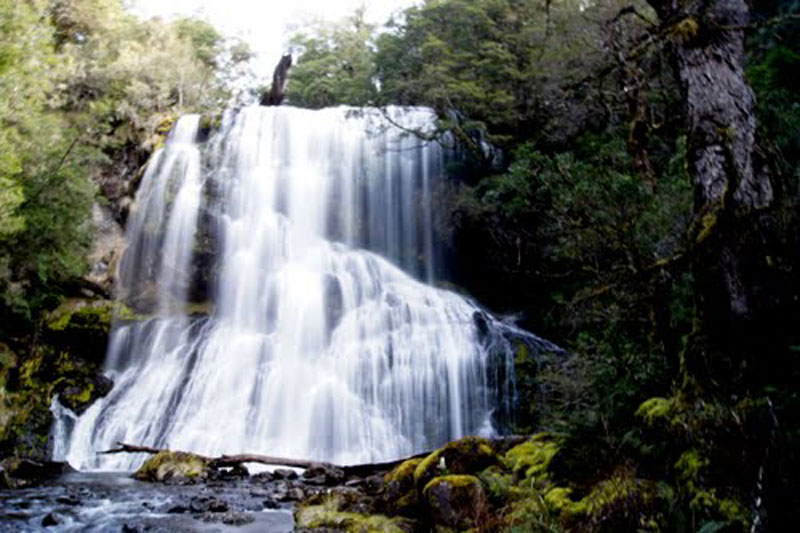
Bridal Veil Falls
Bridal Veil Falls are one of two lovely waterfalls at Moina, near Cradle Valley. The falls tumble 15-20m into Bulls Creek and when flowing well, look like a rectangular curtain of water. In lower flows, the wall of water becomes columnar strands draping the underlying rock wall. Combining this waterfall with Champagne Falls, below, makes for an excellent half day walk.

Champagne Falls
To visit nearby Champagne Falls, take the track past the manager's residence of Lemonthyme Lodge Wilderness Retreat, as previously mentioned, for Bridal Veil Falls, and follow the signs to Champagne Falls. The 15m high falls are in a shady area of Bulls Creek. Allow 3 hours to comfortably take in both waterfalls. These falls are near Lemonthyme Lodge Wilderness Retreat at Moina, near Cradle Valley section of Cradle Mountain Lake St Clair National Park, Tas.

A PocketOz Travel and Information Guide
Design and concept © Stephen Yarrow | Email | W3Layouts | Test